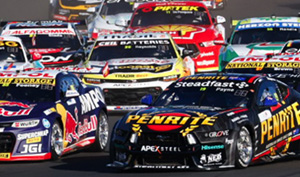DARWIN data has dismissed concerns of an engine disparity, Supercars general manager of motorsport Tim Edwards has revealed.
For the second successive year, the Hidden Valley round was dominated by Camaro teams and drivers – and given that aero parity was agreed upon following off-season wind tunnel testing, the blame seemed to shift to engines.
V8 Sleuth understands that theory has since largely been retracted after relevant data was distributed.
“Prior to Darwin, all teams received torque sensor data from all rounds so far this year, so that their individual engineering departments could all make their own assessment of what has been achieved so far,” Edwards told V8 Sleuth.
“Subsequent to Darwin, we have provided both the HTs (homologation teams) with torque sensor data from that event and we also provided them with some straight-line analysis as well.
“Because obviously they get some very coarse data just from the timing system, but we have actually provided both of the homologation teams with some straight-line overlays from the Shootout from the fastest Ford and the fastest GM, and what that showed is they were identical in that.

“We’re still comfortable that we’re in a good place, but AVL (the upcoming transient dyno testing) is still the final tick of the box to understand the engines. But as I’ve said in the past, we are very close.”
Top 10 Shootout data is considered the ‘cleanest’ to analyse, given the lack of variables such as traffic and slipstreams.
So, how did the pendulum swing so drastically from Ford in Perth to Chevrolet in Darwin?
“Our tracks are very different. We use different compound tyres at different tracks and they also suit different team set-ups and different drivers’ driving styles,” said Edwards.
“There’s a lot of variables, but we also know from the analysis that Supercars did that there was very different chassis set-ups up and down the pitlane.
“I know the set-up that was in the fast cars and I know the set-up that was in the not-so-fast cars, and not surprisingly, they weren’t the same. So we know the differences there.
“But that’s sporting parity, that’s for the teams and the drivers to figure that bit out, and what our responsibility is, is to make sure that technically our key pillars of engine and aero and CoG (Centre of Gravity), et cetera, that there’s parity there.
“Unfortunately, when your favourite team mightn’t be at the front, it’s not always down to parity.”
Edwards believes data transparency has helped teams have general confidence in the 2024 parity situation.
“The more open we are with the data, the more it helps the engineers to get a clear understanding of where they need to be focusing their attention. That’s why we have shared that information,” he said.
“We don’t always send direct to the teams, sometimes it goes through the homologation teams; first and foremost we need to keep them abreast of what’s going on, because we’re dealing with them for instance on things like AVL. Not all of the teams are involved in the planning and preparation for that and what’s going to be tested.
“But like I said, before Darwin we shared with all of the teams all of the torque sensor data from this year, and we’ll continue to do that.
“We’re giving them that information to try to make it easier for them to not just focus on something that they have only got very coarse data for, because you can easily make the wrong assumption.”
Dick Johnson Racing and Triple Eight are the respective Supercars homologation teams for Ford and Chevrolet.





